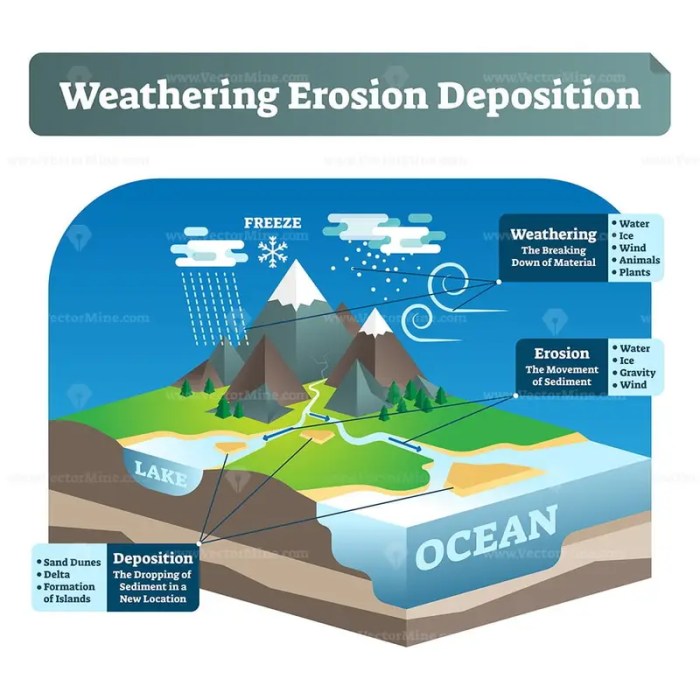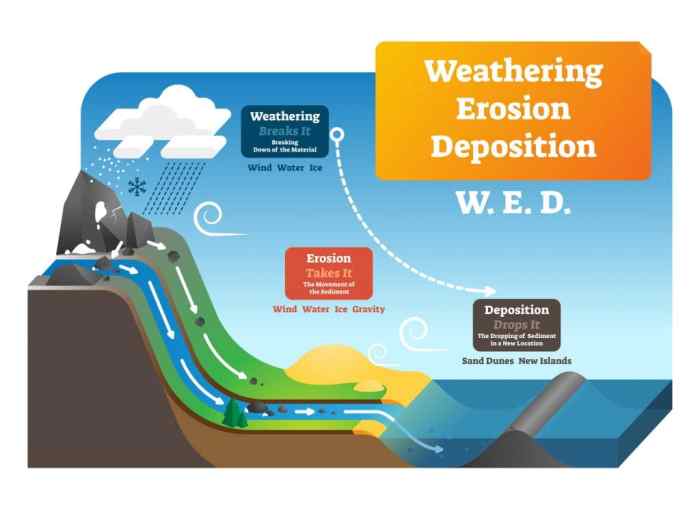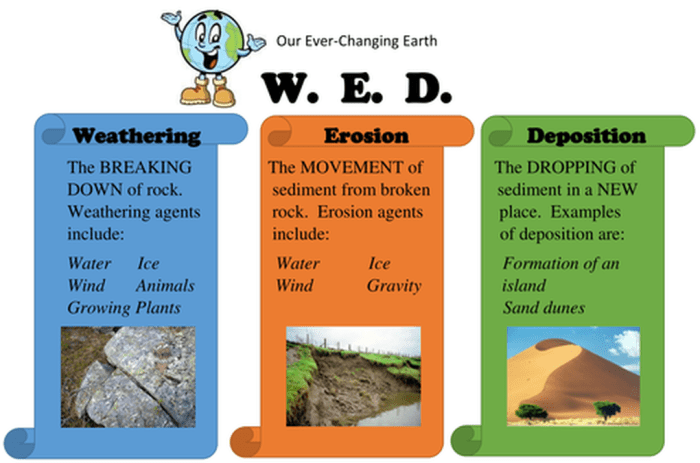Diagram of weathering erosion and deposition – The diagram of weathering, erosion, and deposition unveils a captivating narrative of the dynamic processes that sculpt our planet’s surface. Weathering, erosion, and deposition, the trifecta of geomorphic agents, orchestrate a symphony of change, transforming landscapes over time scales both vast and minute.
This intricate interplay shapes the contours of mountains, carves river valleys, and molds coastlines, leaving an enduring imprint on the Earth’s physiography.
Weathering, Erosion, and Deposition: A Comprehensive Overview

Weathering, erosion, and deposition are fundamental processes that shape the Earth’s surface and play a crucial role in landscape formation. Understanding these processes is essential in various fields, including geology, environmental science, and land management.
Define Weathering, Erosion, and Deposition
Weatheringis the process of breaking down rocks and minerals into smaller fragments. It occurs due to various factors, including temperature changes, water action, chemical reactions, and biological activity.
Erosionis the process by which weathered materials are transported from one location to another by wind, water, or ice. Erosion can cause significant changes in landforms and can lead to soil loss and sedimentation.
Depositionis the process by which eroded materials are deposited in new locations. Deposition can create new landforms, such as deltas and sand dunes, and can contribute to soil formation.
Diagrammatic Representation of Weathering, Erosion, and Deposition, Diagram of weathering erosion and deposition
| Process | Description | Example | Illustration |
|---|---|---|---|
| Weathering | Breaking down of rocks and minerals | Frost wedging, chemical weathering | [Diagram of frost wedging and chemical weathering] |
| Erosion | Transportation of weathered materials | River erosion, wind erosion | [Diagram of river erosion and wind erosion] |
| Deposition | Deposition of eroded materials | Delta formation, sand dune formation | [Diagram of delta formation and sand dune formation] |
Role of Weathering, Erosion, and Deposition in Landscape Formation
Weathering, erosion, and deposition are the primary processes responsible for shaping the Earth’s surface. Weathering breaks down rocks and minerals, creating smaller particles that are more easily eroded by wind, water, or ice. Erosion then transports these particles to new locations, where they are deposited and can form new landforms.
Weathering can also create unique rock formations, such as hoodoos and mesas. Erosion can shape mountains, valleys, and rivers, while deposition can create deltas, sand dunes, and beaches.
Factors Influencing Weathering, Erosion, and Deposition
The rates of weathering, erosion, and deposition are influenced by a variety of factors, including:
- Climate:Temperature and precipitation play a significant role in weathering and erosion. Higher temperatures and more frequent rainfall can accelerate these processes.
- Rock type:Different types of rocks have different susceptibilities to weathering and erosion. Softer rocks, such as sandstone, are more easily weathered and eroded than harder rocks, such as granite.
- Vegetation:Vegetation can help to protect rocks from weathering and erosion by providing a protective layer of organic matter.
- Slope:Steeper slopes are more susceptible to erosion than gentler slopes, as gravity pulls weathered materials downslope.
Impacts of Weathering, Erosion, and Deposition on the Environment
Weathering, erosion, and deposition can have both positive and negative impacts on the environment:
- Positive impacts:Weathering can help to create new soil, which is essential for plant growth. Erosion can transport sediments to new locations, where they can be deposited and form new landforms. Deposition can create new habitats for plants and animals.
- Negative impacts:Erosion can lead to soil loss, which can reduce agricultural productivity. Erosion can also cause sedimentation of rivers and lakes, which can harm aquatic ecosystems. Deposition can block waterways and disrupt navigation.
Applications of Understanding Weathering, Erosion, and Deposition
Understanding weathering, erosion, and deposition is essential in a variety of fields, including:
- Geology:Geologists study weathering, erosion, and deposition to understand the formation of the Earth’s surface and the history of the planet.
- Environmental science:Environmental scientists study weathering, erosion, and deposition to assess the impacts of these processes on the environment and to develop strategies to mitigate their negative effects.
- Land management:Land managers use their understanding of weathering, erosion, and deposition to make decisions about land use and to develop strategies to protect soil and water resources.
Query Resolution: Diagram Of Weathering Erosion And Deposition
What is the difference between weathering and erosion?
Weathering refers to the breakdown of rocks and minerals at or near the Earth’s surface, primarily through chemical and physical processes. Erosion, on the other hand, involves the transportation and deposition of weathered materials by agents such as water, wind, and ice.
How does deposition contribute to landscape formation?
Deposition occurs when eroded materials are deposited in new locations, often forming landforms such as deltas, sand dunes, and floodplains. These deposits can significantly alter the topography and hydrology of a region.
What are some factors that influence the rates of weathering, erosion, and deposition?
Factors such as climate, rock type, vegetation cover, and human activities can all influence the rates at which these processes occur. For example, humid climates promote chemical weathering, while arid climates favor physical weathering.

